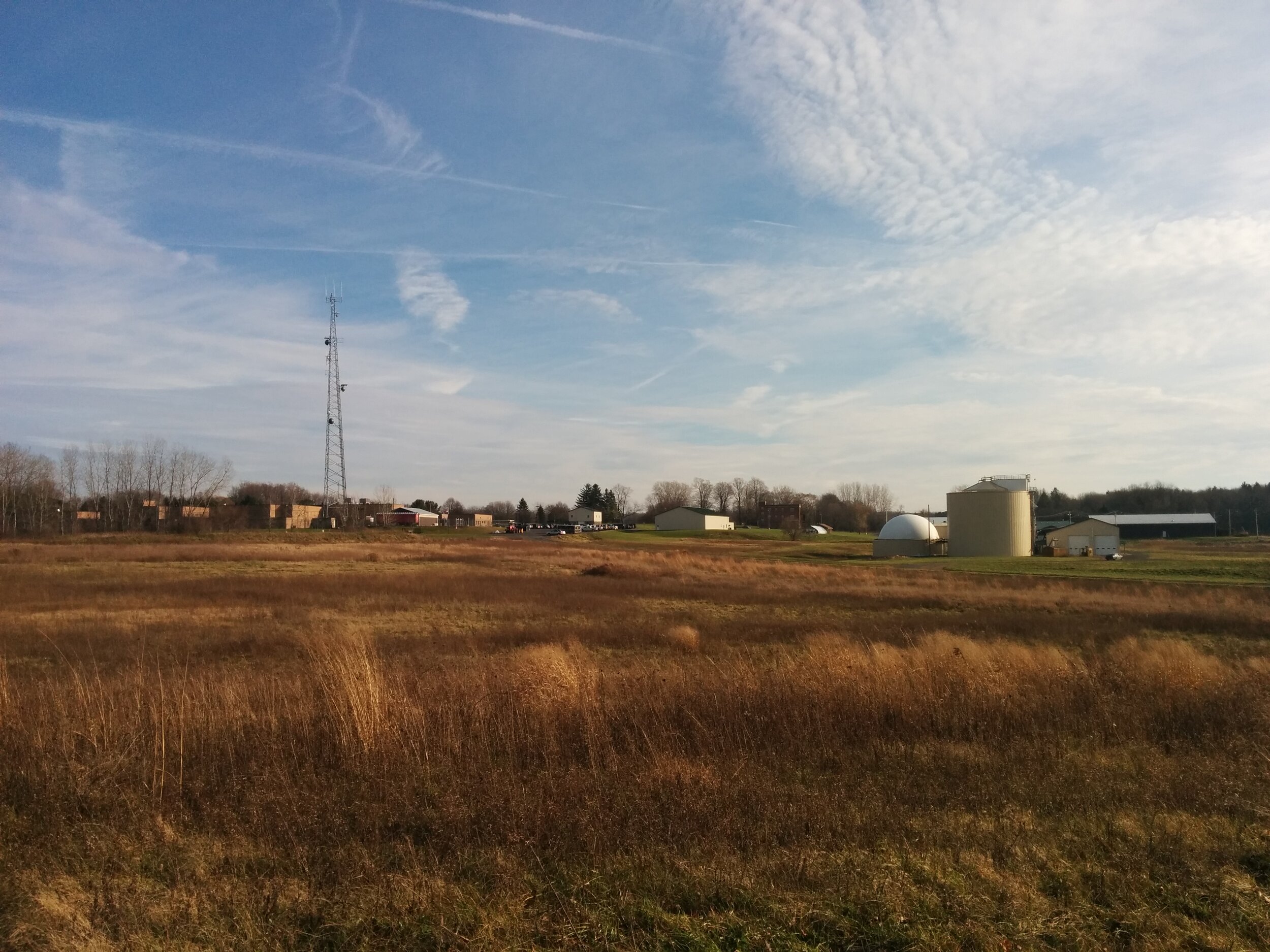
Frequently asked questions.
What is an anaerobic digester?
Anaerobic digesters utilize processes in which naturally occurring micro-organisms break down plant and animal materials, commonly referred to as feedstock, inside a sealed tank. This creates a biogas which is harnessed to produce renewable heat and electricity. Once waste has been processed, the remaining organic material is used as a nutrient-rich fertilizer. This unique generation process helps reduce fossil fuel dependency while diverting waste that would otherwise contribute to climate change in landfills.
There are more than 250 anaerobic digesters operating in the United States. To learn more about anaerobic digestion and how the technology is implemented across the United States, visit the dedicated US Environmental Protection Agency webpage for anaerobic digestion.
What is the Cayuga Regional Digester?
The Cayuga Regional Digester plays an important role in Central New York’s recycling community. The facility is an organics recycling and energy hub that provides a source of clean, renewable electricity to more than 1,100 homes in the area. The Digester provides a sustainable and productive alternative for food waste that would otherwise be sent to landfills in the region and contribute to climate change. Once this waste has been used for energy production, it then supports our local agriculture industry as a nitrogen-rich, organic fertilizer for more than 1,000 acres of farmland each year.
While many forms of renewable energy, like wind and solar, provide an intermittent source of power that can be impacted by environmental conditions, anaerobic digesters are a source of consistent, baseload renewable energy. The Cayuga Regional Digester’s method of processing food waste is similar to composting, resulting in a nutrient rich fertilizer that is not only beneficial to crops, but to the soil itself.
Where does the Digester obtain its waste?
The Cayuga Regional Digester obtains food waste from more than 40 sources per month, including packaged food manufacturers, growers, food processors, and distributors located across New York. This waste consists of food manufacturing biproducts and items that are no longer fit for human consumption, such as expired applesauce.
What types of waste does the Digester NOT receive?
The Digester does not take any form of hazardous waste and has processes in place to prevent any hazardous waste from entering the facility. Anaerobic digestion is a biological process similar to the processes that occur in the human stomach. Feeding the digester products that aren’t easily digestible would disturb the biological process and disrupt the plant.
The Cayuga Regional Digester does not process municipal waste, human waste or septage – it processes feedstock from the agriculture and food industries such as spoiled food and unusable crop residuals.
What organization oversees the Cayuga Regional Digester’s operations?
The Cayuga Regional Digester is regulated by the New York State Department of Environmental Conservation. The Digester team conducts extensive testing to ensure we maintain environmental compliance while providing valuable renewable energy and nutrient-rich fertilizer for our community.
How does the Cayuga Regional Digester prevent odors at the plant?
Our team has implemented, and is continuously improving, multiple odor mitigation solutions, including improved loading processes and filtering process air at the Cayuga Regional Digester. We strive to be a great neighbor and valuable member of our community.
How do I submit an odor complaint to the Cayuga Regional Digester?
The Cayuga Regional Digester is committed to responding to neighbors’ feedback in a timely manner that contributes to a positive, productive, community conversation. Community members with any concerns regarding odor issues are encouraged to reach out via our online complaint portal to ensure issues can be resolved quickly and effectively.
You can submit a complaint on this website via the Contacts page or email info@Cayugadigester.com.
How does the Cayuga Regional Digester benefit the community?
The Cayuga Regional Digester spends a majority of its annual budget within the community on salaries, property taxes and local contractors. This provides a significant economic impact in Cayuga County each year.
The Cayuga Regional Digester works directly with local farmers to provide a low-cost, nitrogen-rich fertilizer for an excess of 1,000 acres of fields. This fertilizer displaces fossil fuel based synthetic fertilizer that would otherwise be used on the fields.
The Cayuga Regional Digester employs 8 staff members, 6 of which are full time employees. We also provide community members with training and well-paying, fulfilling renewable energy careers. The Digester is also a member of the Alliance for Clean Energy New York.
How does the Cayuga Regional Digester impact local sustainability?
The Cayuga Regional Digester plays an important role in the Central New York recycling community, helping provide both a powerful landfill diversion tool, as well as a source of clean, reliable and renewable power for the communities it serves.
While many forms of renewable energy, like wind and solar, provide an intermittent source of power, the Cayuga Regional Digester is a source of consistent, baseload renewable energy, capable of powering more than 1,100 local homes. The Cayuga Regional Digester’s method of processing food waste is similar to composting, resulting in a nutrient rich fertilizer that is not only beneficial to crops, but to the soil itself.
Food waste processed by the Cayuga Regional Digester would likely otherwise be sent to a landfill. By redirecting that waste to the digester, organizations can support their zero landfill initiatives while saving costs in the process. The Digester’s operations alone divert 60,000 tons of food waste and packaging from landfills each year.
The Cayuga Regional Digester also captures the heat produced by the engines through a series of heat exchangers. This captured thermal energy is used throughout the site to heat building and process tanks, contributing to efficient and sustainable operations.
How does the Cayuga Regional Digester help the community?
The Cayuga Regional Digester is committed to being a good neighbor and appreciates all feedback from the community.
More details about our community efforts can be found on the Community tab of our website.
Still have questions? Email us at info@Cayugadigester.com.
